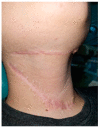Pediatric Cervicofacial Necrotizing Fasciitis-A Challenge for a Medical Team
- PMID: 37508759
- PMCID: PMC10378044
- DOI: 10.3390/children10071262
Pediatric Cervicofacial Necrotizing Fasciitis-A Challenge for a Medical Team
Abstract
Cervical necrotizing fasciitis is a very rare complication of a bacterial infection that can have a dental cause. This type of infection typically affects fascial plane, which has a poor blood supply and can affect soft tissue and cervical fascia and can spread quickly causing infection of mediastinum. Initially, in the first stage, the overlying tissues are unaffected, and this can delay diagnosis and surgical intervention. Incidence in children is extremely rare and can be frequently associated with various other general pathologies that decrease the immune system response. We present a case of a young 12-year-old boy diagnosed with this type of infection in the head and neck as a complication of a second inferior molar pericoronitis. The treatment and the management of the case was difficult not only due to the presence of the infection but also because of the prolonged intubation.
Keywords: multidisciplinary approach; necrotizing fasciitis; odontogenic infection; pericoronitis.
Conflict of interest statement
The authors declare no conflict of interest.
Figures









Similar articles
-
Odontogenic Infection Complicated by Cervicofacial Necrotizing Fasciitis in a Healthy Young Female.Cureus. 2021 Aug 2;13(8):e16835. doi: 10.7759/cureus.16835. eCollection 2021 Aug. Cureus. 2021. PMID: 34513425 Free PMC article.
-
Necrotizing Fasciitis.2023 Feb 21. In: StatPearls [Internet]. Treasure Island (FL): StatPearls Publishing; 2025 Jan–. 2023 Feb 21. In: StatPearls [Internet]. Treasure Island (FL): StatPearls Publishing; 2025 Jan–. PMID: 28613507 Free Books & Documents.
-
Necrotizing odontogenic fasciitis of head and neck extending to anterior mediastinum in elderly patients: innovative treatment with a review of the literature.Aging Clin Exp Res. 2017 Feb;29(Suppl 1):159-165. doi: 10.1007/s40520-016-0650-2. Epub 2016 Oct 31. Aging Clin Exp Res. 2017. PMID: 27798811
-
Cervicofacial necrotizing fasciitis: report of three cases and literature review.J Oral Maxillofac Surg. 1988 Jun;46(6):450-9. doi: 10.1016/0278-2391(88)90410-7. J Oral Maxillofac Surg. 1988. PMID: 3288731 Review.
-
Paralysis of cranial nerve and striking prognosis of cervical necrotizing fasciitis.J Craniofac Surg. 2012 Nov;23(6):1812-4. doi: 10.1097/SCS.0b013e318271024e. J Craniofac Surg. 2012. PMID: 23147345 Review.
References
Publication types
Grants and funding
LinkOut - more resources
Full Text Sources

